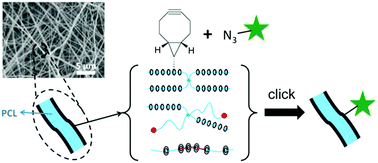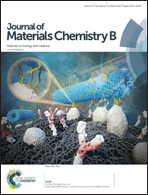The study of the pseudo-polyrotaxane architecture as a route for mild surface functionalization by click chemistry of poly(ε-caprolactone)-based electrospun fibers†
Abstract
Polycaprolactone (PCL) electrospun fibers are widely developed for biomedical applications. However, their hydrophobicity and passivity towards cell growth is an important limitation. An original method to functionalize PCL nanofibers, making them reactive for bioconjugation of proteins or other molecules of interest in water under mild conditions, is reported here. This method involves the preparation of pseudo-polyrotaxanes (pPRs) of cyclodextrin (CD) and PCL. Core:shell PCL:pPR fibers were then prepared by coaxial electrospinning in order to bring available reactive hydroxyl groups from the CD to the fiber surface. Different pPR architectures (star, miktoarm and block-copolymer-like) were synthesized to study the effect of the pPR structure on fiber morphology and surface reactivity by grafting fluorescein isothiocyanate (FITC). Finally, bicyclononyne groups were grafted onto the star-pPR based fibers allowing the conjugation of a fluorescent dye by click chemistry in water without any copper catalyst proving the potential of the method for the biofunctionalization of PCL-based fibers.



 Please wait while we load your content...
Please wait while we load your content...